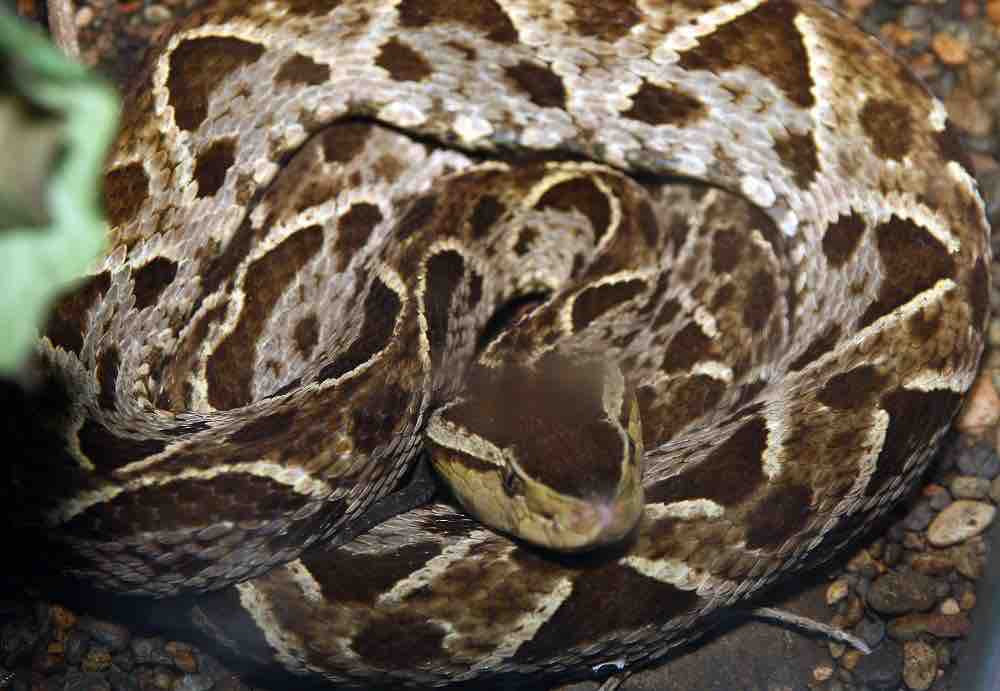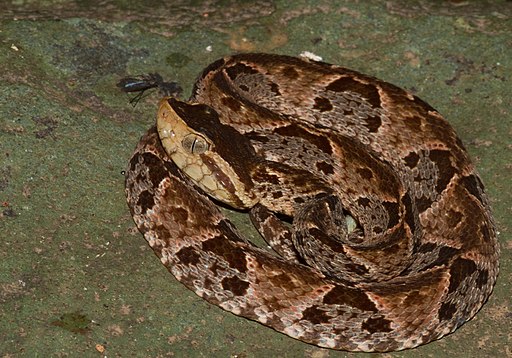
Behavior, Characteristics, Reproduction, Effects of the poison, What does it eat?
The Fer-de-lance snake (Bothrops asper) is a very venomous crotaline snake, found in a variety of environments: in tropical rainforests, evergreen forests and even in drier regions such as tropical deciduous forests.
Its distribution goes from the south of Mexico, continues along Central America and South America, in Colombia, Venezuela, Ecuador and up to the north of Peru, in Tumbes.
It is famous everywhere for its lethality, which is only matched in the American lowlands by the common lancehead or yellowbeard snake (B. atrox) and the rattlesnake (Crotalus durissus).
It is found almost always in lowlands, from 0 to 1,200 meters above sea level, although it has been found in the highlands of Venezuela and Colombia, between 2,500 and 2,600 meters above sea level. Their adaptive flexibility, which leads them to venture into farm fields and the homes of villagers in search of Rodents, their favorite prey, has worked against their conservation, because they are considered a danger, as indeed they are in the vicinity of human settlements, and are therefore eliminated.
Common names of the Fer-de-lance
The fer-de-lance has many names, corresponding to the different regions where it is present: four noses snake in Mexico, yellowbeard snake in Guatemala, serpiente equis or equis (X-Snake) in Panama and Ecuador, terciopelo (velvet snake) in several places, especially in Costa Rica and Venezuela, mapaná, or talla equis (Colombia).
There is usually much confusion between this species and B. atrox, known as yellowbeard, and even with the Colombian toad-headed pitviper (B. colombiensis).
Behavior of the Fer-de-lance snake
The fer-de-lance is very nervous and irritable. It usually rests under, or is confused with, leaf litter.
Most accidents, some fatal if not attended to in time, are caused by someone carelessly stepping on them.
They are very fast and rise to bite, allowing them to bite their human victim above the knee. And they can even expel their strong venom, as fine jets, from the tip of their fangs up to a distance of almost 1.8 m (4 ft).
The fer-de-lance is nocturnal, and is a terrestrial animal, rarely climbing trees. When young, they have a tendency to climb trees, but not as adults.

Ordinarily, it does not attack without having been previously disturbed. It may even try to flee, but is fearsome when cornered and forced into a confrontation.
Specialists advise to let it go, without trying to kill it, because it is very aggressive.
Characteristics of Bothrops asper
The species presents a marked sexual dimorphism. The female is longer, thicker and heavier than the male. The female reaches a length of 1.85 to 2.5 m, and weighs about 6 kg.
The male, on the other hand, is smaller, measuring between 1.4 and 1.80 m, and less heavy.
The head of the fer-de-lance is very defined, with a triangular shape. The female’s head is two to three times larger than the male’s, and so are its tusks, which can be up to 2.5 cm long.
The skin color of the fer-de-lance has various shades of brown, dark gray or shades of brown, turning pale yellow on the underside of the head.
The snake has a series of small triangles on both sides of the body.
One of the most important peculiarities of the species is that it has, on each side of its head, a pit or depression called fossa lorealis, located between the eye and the snout, which the snake uses to detect potential prey that emits infrared radiation.
The loreal pit or thermoreceptor cavity is used by crotaline snakes to perceive from a distance, and even in complete darkness, animals that feed on the heat radiated by their own bodies.
The loreal pit is not exclusive to the fer-de-lance and this fossette is possessed by several genera of the Viperidae family.

Source: Robert Wedderburn, CC BY-SA 3.0, via Wikimedia Commons
Reproduction of the fer-de-lance
Mating in this species occurs at various times of the year, and apparently biannually, but is related to the time of the heaviest rainfall. Gestation takes 180 to 240 days.
Being a viviparous animal, the young are born alive, with a litter of about 30 or more young. This reproductive form is not so common among snakes. According to University of Georgia biologist Whit Gibbons, only 15-20% of the 9,000 known snake species are viviparous.
Up to 90 hatchlings have been observed in a litter. But not all hatchlings survive.
The hatchlings feed by attracting small prey with the tips of their tails, which are yellowish when they are born, but later change color as they molt.
Bothrops asper type of venom
The bite, or “sting” as it is commonly referred, is very poisonous, and must be treated promptly.
Antiophidic serums are very effective if applied in time. It immediately produces intense pain, oozing from the wound and increasing swelling in the affected limb.
The bitten person feels headache, slight fever, bleeding from the nose and gums, hemorrhage, hypotension, nausea and vomiting, and altered consciousness.
If the wound becomes necrotic, amputation of the affected limb is necessary to save the patient.
What does the fer-de-lance eat?
The diet of the fer-de-lance is “generalist,” that is, they do not have specific requirements, but eat a wide variety of small animals: rats, mice, frogs, and even other snakes.
There is much confusion with the identification of the species for non-experts, and B. asper is confused with B. atrox, also called yellowbeard or yellowhead, and B. colombiensis. Although, Calvete et al (2009) say that the venom that innoculates the victims is 65 to 70% similar in their venom proteomes.
Bibliography
- Calvete J.J., Borges A., Segura A., Flores-Díaz M. (2009). Shake venomics and antivenomics of Bothrops colombiensis, a medical import pitviper of the Bothrops asper complex endemic to Venezuela: Contribution to its taxonomy and snakebie management. Journal of Proteomics, Vol. 72 (2), 06 March, 227-240. Source
- Cumbre Pueblos (2018). Velvet snake. Cumbrepuebloscop20.org /animals /snake/terciopelo. Source
- Sasa M., Wasko D.K., Lamar W.W., (2009). Natural history of the terciopelo Bothrops asper (serpentes: Viperidae) in Costa Rica. Toxicon, Vol. 54 (7), 01 December, 904-922. Source
- Texeira C., Cury Y., Moreira V., Picolo G., Chaves F. (2009). Inflammation induced by Bothrops asper venom. Toxicon, Vol. 54 (7), 01 December. 988-997. Source
- University of Costa Rica. (2018). The velvet. Science and Technology, 04. 04. 2018. Ucr.ac.cr/noticias/208/04/04/la-tciopelo.html. Source
- Warrell D.A. (2004). Snakebites in Central and South America: Epidemiology, Clinical Feature, and Clinical Management, in: Campbell J.A., Lamar W.W., Lamar W.W.. The Venomous Reptiles of the Western Hemisphere. Ithaca-London: Comstock Publishing Associates. PDF

Dr. Rafael Cartay is a Venezuelan economist, historian, and writer best known for his extensive work in gastronomy, and has received the National Nutrition Award, Gourmand World Cookbook Award, Best Kitchen Dictionary, and The Great Gold Fork. He began his research on the Amazon in 2014 and lived in Iquitos during 2015, where he wrote The Peruvian Amazon Table (2016), the Dictionary of Food and Cuisine of the Amazon Basin (2020), and the online portal delAmazonas.com, of which he is co-founder and main writer. Books by Rafael Cartay can be found on Amazon.com
This post is also available in:
![]() Español (Spanish)
Español (Spanish)
